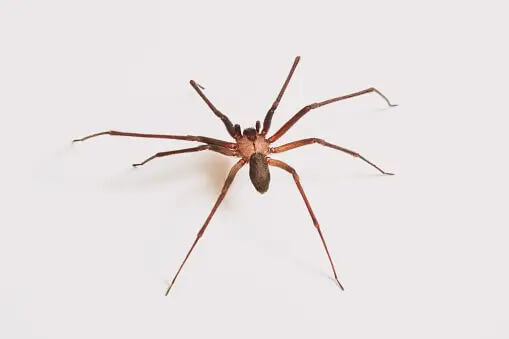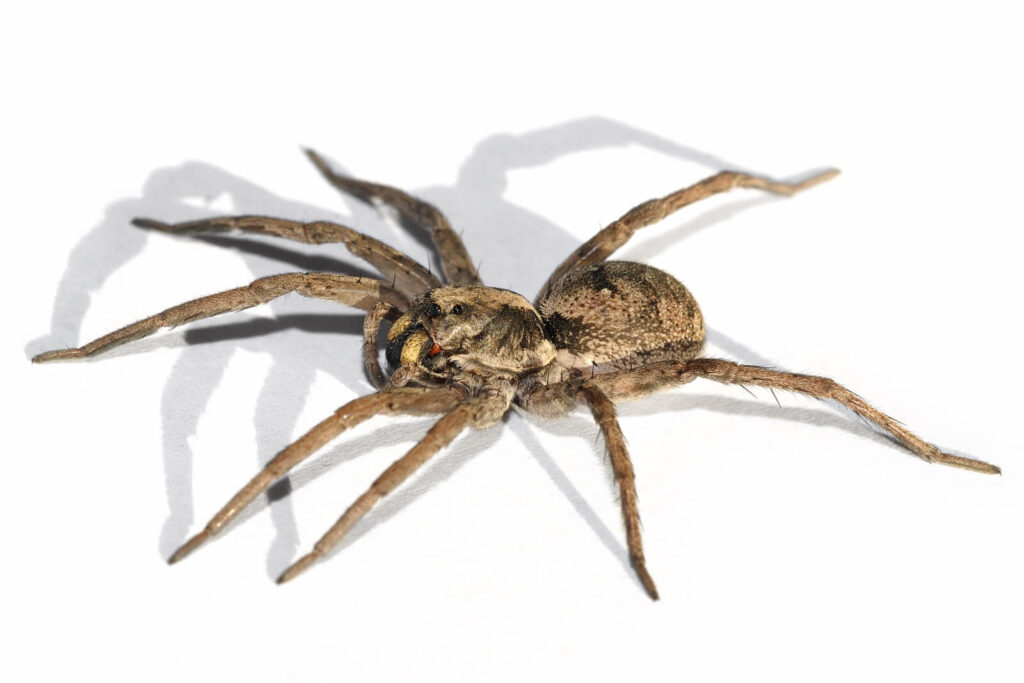Hello Everyone, Navigating the world of spiders can be both fascinating and challenging. Two distinct arachnids that often capture our attention are the brown recluse spider and the wolf spider. These two species are frequently encountered, yet they differ in various aspects, from appearance to behavior. Understanding the nuances between the brown recluse and the wolf spider can help demystify their presence and foster a deeper appreciation for the intricate web of life they inhabit.
What are brown recluse spiders?
Brown recluse spiders, scientifically known as Loxosceles reclusa, are intriguing arachnids that have garnered attention due to both their elusive nature and their potential danger. These spiders are typically recognized by the distinct violin-shaped marking on their cephalothorax, which gives rise to their alternate name, the “fiddleback” spider. Their body color ranges from light tan to dark brown, further aiding in their identification.
Found primarily in the southern and central United States, brown recluse spiders prefer quiet, sheltered spots such as closets, attics, basements, and woodpiles. Despite their name, they don’t actively seek out human interaction. Instead, they prefer to hide in dark corners and crevices. While they do possess venom that is used to incapacitate their prey, these spiders are not aggressive towards humans and only bite in self-defense when they feel threatened or cornered.
Brown recluse bites, though relatively rare, can have serious consequences. The venom can cause tissue necrosis, leading to an ulcer that requires medical attention. However, it’s important to note that most bites result in mild symptoms resembling a mosquito bite. It’s crucial to exercise caution and seek medical care if you suspect you’ve been bitten by a brown recluse, especially if you experience symptoms beyond localized pain and redness.
These spiders play a vital role in ecosystems by controlling insect populations, contributing to the balance of nature. While brown recluse spiders might evoke fear due to their potential bite, understanding their habits, habitats, and behaviors can help alleviate unnecessary concerns and foster coexistence with these intriguing arachnids.
What are wolf spiders?
Wolf spiders, belonging to the family Lycosidae, are a diverse group of arachnids known for their active hunting behavior and robust appearance. These spiders get their name from their hunting strategy, which resembles that of wolves – they stalk and chase down their prey instead of relying on webs to catch it. With over 2,300 species identified worldwide, wolf spiders can be found in a variety of habitats, from forests and grasslands to deserts and even gardens.
Characterized by their large size and stout bodies, wolf spiders are usually brown, gray, or black in color, helping them blend seamlessly into their surroundings. Their robust physique enables them to be formidable hunters, often ambushing their prey with incredible speed. Wolf spiders have excellent vision, thanks to their arrangement of eight eyes that offer keen eyesight for both day and night hunting.
Unlike some other spiders, wolf spiders do not spin intricate webs to capture prey. Instead, they use silk to create retreats or shelters in burrows or crevices. These silk-lined burrows offer a safe haven where they rest and protect their eggs, ensuring their survival in a dynamic environment.
Despite their formidable appearance, wolf spiders are not considered harmful to humans. While they possess venom that they use to immobilize their prey, their venom is not potent enough to cause serious harm to humans. Bites from wolf spiders might result in localized pain, redness, and swelling, akin to a bee sting. However, their non-aggressive nature means they only bite when provoked or accidentally handled.
As skilled predators, wolf spiders play a crucial role in maintaining ecological balance by controlling insect populations. Observing their agile hunting behavior and understanding their role in the intricate web of life can inspire a greater appreciation for these often misunderstood creatures and their valuable contribution to ecosystems.
Brown Recluse Spider Overview

- Scientific Name: Loxosceles reclusa
- Size: Approximately 6 to 20 millimeters in body length.
- Distinctive Marking: Known for the violin-shaped marking on its cephalothorax.
- Habitat: Prefers dark, quiet, and sheltered spaces like closets, attics, basements, and woodpiles.
- Range: Primarily found in the southern and central regions of the United States.
- Nocturnal Behavior: More active during the night, seeking prey such as insects.
- Camouflage: Variable coloration, ranging from light tan to dark brown, enabling effective camouflage.
- Eye Arrangement: Possesses six eyes arranged in three pairs, distinct from the typical eight-eyed arrangement.
- Venomous Nature: Venom contains enzymes that can break down tissue upon envenomation.
- Non-Aggressive: Not aggressive towards humans; bites are often a result of accidental contact or feeling threatened.
- Bite Symptoms: Most bites result in localized pain, redness, and swelling similar to a bee sting.
- Necrotic Venom: In some cases, venom can cause tissue necrosis, leading to the formation of an ulcer.
- Medical Attention: Severe bites require medical attention; prompt care can mitigate complications.
- Range and Distribution: Habitat extends from the southern United States into parts of the Midwest.
- Identification: Not all brown spiders are brown recluse spiders; specific features like the violin-shaped marking and eye arrangement aid identification.
- Ecosystem Role: Despite its reputation, the brown recluse contributes to ecosystems by controlling insect populations.
- Coexistence: Understanding the spider’s behavior and habitat can lead to coexistence while exercising caution.
- Misidentification: Common misidentification highlights the importance of accurate identification to dispel unwarranted fears.
- Balance in Nature: By appreciating its unique traits, individuals can respect the balance of nature and contribute to their local ecosystems.
In summary, the brown recluse spider, scientifically known as Loxosceles reclusa, is a distinctive arachnid with a violin-shaped marking on its cephalothorax. Found primarily in the southern and central United States, it prefers sheltered habitats and contributes to ecosystem balance by controlling insect populations. While its venomous nature warrants caution, understanding its characteristics, habitat preferences, and potential dangers can foster coexistence and appreciation for this intriguing arachnid.
Wolf Spider Overview

- Diverse Family: Belongs to the family Lycosidae, encompassing a wide variety of species.
- Active Hunters: Known for their active hunting behavior instead of relying on webs for prey capture.
- Hunting Strategy: Stalk and chase down prey, similar to wolves, earning them the name “wolf spider.”
- Global Distribution: Over 2,300 species worldwide, inhabiting diverse habitats from forests to deserts.
- Size and Appearance: Generally larger in size, with robust bodies and varying colors, blending into surroundings.
- Distinctive Eyes: Possess eight eyes arranged for keen eyesight, aiding in day and night hunting.
- Web Usage: Unlike many other spiders, wolf spiders do not build intricate webs to catch prey.
- Silk Retreats: Use silk to create retreats or shelters in burrows or crevices, offering protection and a place to rest.
- Egg Protection: Silk-lined burrows safeguard eggs, ensuring survival in challenging environments.
- Non-Venomous Bite: Possess venom to immobilize prey, but bites are typically not harmful to humans.
- Habitual Shyness: Generally non-aggressive and avoid human contact, preferring to retreat.
- Habitat Range: Inhabit various ecosystems, from forests and grasslands to gardens and deserts.
- Role in Ecosystems: Key predators controlling insect populations, maintaining ecological balance.
- Bite Symptoms: Bites might cause localized pain, redness, and swelling similar to a bee sting.
- Nocturnal Behavior: Primarily active during the night, exhibiting agile hunting techniques.
- Hunting Techniques: Stalk and pounce on prey, utilizing exceptional speed and ambush tactics.
- Avoiding Humans: Wolf spiders usually flee when encountered, seeking refuge in nearby hiding spots.
- Educational Value: Studying wolf spiders contributes to understanding arachnid behavior and ecological roles.
- Beneficial Allies: Despite their appearance, wolf spiders play a crucial role in maintaining insect populations.
- Fascinating Observations: Witnessing their hunting prowess offers a glimpse into the intricate balance of nature.
Wolf spiders, members of the Lycosidae family, exemplify active hunting behavior and diverse species. Their robust appearance and agile hunting tactics make them valuable contributors to ecosystems worldwide. Despite their size and often misunderstood nature, they are generally non-harmful to humans. Appreciating their role in maintaining ecological balance and understanding their behaviors can foster coexistence and respect for these essential arachnids.
What are the similarities between brown recluse spiders and wolf spiders?
Brown recluse spiders and wolf spiders, despite their distinct characteristics, share several similarities that provide fascinating insights into the world of arachnids. Here, we delve into the commonalities that connect these two spider species while appreciating their unique features.
**1. Belonging to the Spider Family: Both brown recluse spiders (Loxosceles reclusa) and wolf spiders (Family Lycosidae) are arachnids, showcasing their shared lineage within the vast spider family.
**2. Predatory Nature: Both species are skilled predators that actively hunt and capture their prey, reflecting their carnivorous habits. While brown recluse spiders primarily target insects, wolf spiders are known for their agile hunting tactics, stalking and chasing down various prey.
**3. Venomous Capabilities: Both spiders possess venom to immobilize their prey, aiding in capturing and consuming insects. However, it’s important to note that while their venom serves a similar purpose, the effects and potency can differ significantly.
**4. Lack of Web Building: Unlike other spider families, both brown recluse and wolf spiders do not build intricate webs for prey capture. Instead, they rely on different strategies—brown recluses seek shelter and ambush their prey, while wolf spiders actively pursue their quarry.
**5. Nocturnal Behavior: Both species are more active during the night, utilizing the cover of darkness to enhance their hunting success. Their adaptations for nocturnal activity, such as enhanced night vision, align with their preferred hunting times.
**6. Camouflage and Coloration: Brown recluse spiders and some wolf spiders exhibit coloration that aids in camouflage within their habitats. The brown recluse’s varying shades of brown blend with its surroundings, while some wolf spiders have patterns that help them remain inconspicuous.
**7. Habitat Preferences: Both spiders show preferences for particular habitats. Brown recluse spiders tend to seek quiet, sheltered spots like closets and attics, while wolf spiders can be found in various environments, from forests to gardens.
**8. Distinct Eye Arrangement: Both species possess eye arrangements that set them apart from other spiders. Brown recluse spiders have six eyes in three pairs, and wolf spiders typically have eight eyes arranged for excellent vision, enhancing their hunting prowess.
**9. Contributions to Ecosystems: Despite their differing hunting strategies, both spiders play crucial roles in maintaining ecosystem balance. Brown recluse spiders control insect populations, while wolf spiders are natural predators that help regulate pest numbers.
While brown recluse spiders and wolf spiders exhibit notable similarities, it’s equally essential to recognize their differences. The brown recluse’s venomous nature and habitat preferences contrast with the wolf spider’s agile hunting techniques and diverse adaptations. Understanding both their shared traits and unique qualities enriches our understanding of the intricate world of arachnids and the dynamic ecosystems they inhabit.
What are the differences between brown recluse spiders and wolf spiders?
Differences Between Brown Recluse Spiders and Wolf Spiders:
1. Scientific Classification:
- Brown Recluse Spider: Belongs to the genus Loxosceles, specifically Loxosceles reclusa.
- Wolf Spider: Classified under the family Lycosidae, with various species falling under this category.
2. Physical Appearance:
- Brown Recluse Spider: Recognizable by its violin-shaped marking on the cephalothorax.
- Wolf Spider: Varied appearance, generally larger and robust, with diverse colors and patterns.
3. Venom Potency:
- Brown Recluse Spider: Possesses venom containing enzymes that can cause tissue necrosis in severe cases.
- Wolf Spider: Generally non-venomous to humans; bites might cause mild irritation similar to a bee sting.
4. Web Usage:
- Brown Recluse Spider: Doesn’t build extensive webs; prefers to ambush prey in sheltered locations.
- Wolf Spider: Also avoids complex webs; actively hunts by stalking and chasing down prey.
5. Eye Arrangement:
- Brown Recluse Spider: Possesses six eyes in three pairs, distinct from the eight-eyed arrangement of most spiders.
- Wolf Spider: Typically has eight eyes arranged in a pattern that enhances its vision for hunting.
6. Habitat Preferences:
- Brown Recluse Spider: Prefers quiet, sheltered spaces like closets and attics.
- Wolf Spider: Found in various habitats, from forests and grasslands to deserts and gardens.
7. Nocturnal Behavior:
- Brown Recluse Spider: Primarily nocturnal, more active during the night.
- Wolf Spider: Also nocturnal, with heightened activity during the night to capture prey.
8. Aggressiveness and Behavior:
- Brown Recluse Spider: Generally non-aggressive, bites are usually a result of feeling threatened or trapped.
- Wolf Spider: May exhibit defensive behavior if provoked but typically avoids confrontation.
9. Range and Distribution:
- Brown Recluse Spider: Primarily found in the southern and central United States.
- Wolf Spider: Diverse species found worldwide, adapted to various environments.
10. Bite Effects:
- Brown Recluse Spider: Bites can result in localized pain, redness, swelling, and in severe cases, tissue necrosis.
- Wolf Spider: Bites usually cause mild irritation, similar to a bee sting, without significant long-term effects.
11. Webbing vs. Hunting:
- Brown Recluse Spider: Non-web-building species, relies on secretive locations and ambush tactics.
- Wolf Spider: Non-web-building species, actively chases down and captures prey using agility and speed.
12. Behavior Toward Humans:
- Brown Recluse Spider: Generally shy and prefers to avoid human contact.
- Wolf Spider: May flee or avoid human interaction, seeking refuge in nearby hiding spots.
13. Ecological Role:
- Brown Recluse Spider: Contributes to insect control in its habitat, helping maintain ecological balance.
- Wolf Spider: Plays a crucial role in regulating insect populations, contributing to ecosystem health.
Understanding these differences highlights the unique characteristics and adaptations of both brown recluse spiders and wolf spiders. While brown recluses possess venom with potentially more serious effects, wolf spiders utilize their agility and hunting prowess to capture prey, showcasing the diversity within the world of arachnids.
Which is more dangerous: a brown recluse spider or a wolf spider?
The question of whether a brown recluse spider or a wolf spider is more dangerous is one that often captures people’s attention. Both spiders possess unique characteristics that warrant consideration, allowing us to differentiate between their potential impact on humans.
Starting with the brown recluse spider, its venom is a cause for concern. The venom contains enzymes that have the potential to cause tissue necrosis, leading to the development of ulcers in severe cases. Although bites from brown recluse spiders are generally uncommon, when they do occur, they can lead to significant health complications. On the other hand, the wolf spider’s venom is typically not harmful to humans. Their bites are known to cause mild irritation, similar to a bee sting, and are unlikely to result in long-term health issues.
Beyond venom, their behavior sets them apart. Brown recluse spiders are usually non-aggressive and prefer to avoid human contact. Bites are typically a defensive response to feeling threatened or cornered. Wolf spiders, on the other hand, are known to be more reclusive and typically flee rather than engage in confrontation. This behavioral distinction contributes to the rarity of wolf spider bites.
Geographically, brown recluse spiders are primarily found in the southern and central United States. Their habitat preferences may result in localized encounters with humans, leading to concerns about potential bites. Wolf spiders, on the other hand, have a broader distribution, inhabiting a wide range of environments worldwide. While encounters are possible, they are less frequent compared to brown recluse spiders.
Considering the effects of their bites, brown recluse spider bites can lead to localized pain, redness, swelling, and tissue necrosis. The severity of reactions depends on factors such as individual sensitivity and the amount of venom injected. Wolf spider bites, although uncomfortable, are not usually considered medically significant.
Both spiders contribute to ecosystems by controlling insect populations, showcasing their beneficial roles. Brown recluse spiders help maintain a balance by managing insect numbers, while wolf spiders actively hunt and regulate prey populations.
In conclusion, while both brown recluse and wolf spiders have attributes that evoke concern, the venom of the brown recluse spider and its potential to cause tissue damage makes it more likely to result in severe health outcomes. Wolf spiders, with their mild venom and non-aggressive behavior, pose significantly less risk to humans. Understanding these differences can aid in addressing fears and cultivating a respectful coexistence with these arachnids.
Where do brown recluse and wolf spiders live?
Habitats of Brown Recluse Spiders:
Brown recluse spiders, scientifically known as Loxosceles reclusa, have distinct habitat preferences that influence their distribution. These spiders are often associated with warmer regions of the United States, particularly the southern and central states. They thrive in environments that offer them shelter and a steady supply of prey. Brown recluse spiders are commonly found in dark and secluded spaces, such as closets, attics, basements, and crawl spaces. They have a propensity for nesting within cluttered areas, old boxes, and piles of clothing.
Outdoors, these spiders tend to inhabit woodpiles, sheds, garages, and other structures that provide the darkness and cover they seek. They may also take up residence in outdoor debris and leaf litter. Their preference for hiding in crevices, cracks, and undisturbed areas contributes to their “reclusive” nature.
Habitats of Wolf Spiders:
Wolf spiders, belonging to the family Lycosidae, are a diverse group with varying habitat preferences. These spiders are known for their agile hunting strategies and can be found in an array of environments around the world. Their adaptability allows them to inhabit diverse ecosystems, including forests, grasslands, deserts, and gardens.
Wolf spiders can be found in both outdoor and indoor settings. Outdoors, they often hide under leaves, logs, rocks, and in burrows they dig themselves. They are known to be ground-dwelling spiders, using their keen eyesight to spot and chase down prey. Wolf spiders are also known to construct silk-lined burrows in which they take refuge.
Indoors, wolf spiders may inadvertently enter homes through open doors or windows. However, they are not known for building extensive webs indoors. Instead, they may seek sheltered corners or crevices, often utilizing their camouflage to blend seamlessly into their surroundings.
Comparison of Habitats:
While both brown recluse spiders and wolf spiders exhibit different habitat preferences, their behaviors converge in their tendency to seek sheltered locations. Brown recluse spiders lean towards quieter spaces within human dwellings, often staying hidden in cluttered areas. In contrast, wolf spiders are more adaptable and occupy a wide range of environments. Their diverse habitats reflect their prowess as agile hunters capable of thriving in various ecological niches.
Understanding the habitats of these spiders enables us to better coexist with them. Employing practices to minimize clutter and sealing potential entry points can discourage brown recluse spiders from taking up residence indoors. For wolf spiders, respecting their outdoor habitats and employing basic pest management practices can maintain a balanced relationship. By appreciating their roles in ecosystems and adopting spider-friendly practices, we can peacefully share our spaces with these arachnid neighbors.
Related Posts
- 18 Types Of BlueBirds
- Feeding the Kings of the Wild
- World’s Largest Birds Revealed
- Exploring (10 Different Species)
- Top 10 Most Dangerous Animals in the World
Conclusion
In the realm of arachnids, comparing the brown recluse spider and the wolf spider highlights distinct differences in their venom potency, behavior, geographic range, and potential impact on humans. While the brown recluse spider’s venom can lead to tissue necrosis and severe bites in rare cases, the wolf spider’s mild venom usually results in minor irritation.
Understanding these variations encourages a balanced perspective on the potential danger posed by these spiders. By appreciating their roles in ecosystems and coexisting with caution, we can foster a harmonious relationship with these intriguing creatures.

